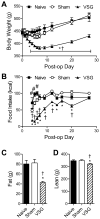The effect of vertical sleeve gastrectomy on food choice in rats
- PMID: 22334194
- PMCID: PMC3355245
- DOI: 10.1038/ijo.2012.18
The effect of vertical sleeve gastrectomy on food choice in rats
Abstract
Objective: Diets high in fat are implicated in the development and maintenance of obesity, and obese individuals display greater preferences for high-fat foods than do their lean counterparts. Weight-reduction bariatric surgery is associated with changes in food choice. In particular, after Roux-en-Y gastric bypass (RYGB), humans and rodents select or prefer foods that are lower in fat content. We asked whether a bariatric surgical procedure limited to the stomach, vertical sleeve gastrectomy (VSG), causes a similar reduction of fat intake/preference.
Research design and methods: Rats received VSG or Sham surgery or remained surgically naïve, and were assessed for food preference using three diet-choice paradigms. Using progressive-ratio (PR) and conditioned taste aversion paradigms, we further asked whether surgically induced changes in food choice are secondary to changes in the reward value of food and/or to the formation of a food aversion. Finally, food choice was compared between VSG- and RYGB-operated rats.
Results: VSG rats decreased their intake of dietary fat, and shifted their preference toward lower caloric-density foods. This change in food choice was not associated with changes in motivated responding on a PR schedule for either a fat or a carbohydrate food reinforcer. When VSG and RYGB were compared directly, both procedures caused comparable changes in food choice. The conditioned taste aversion paradigm revealed that VSG rats form an aversion to an intra-gastric oil administration whereas RYGB rats do not.
Conclusions: VSG and RYGB, two anatomically distinct bariatric procedures, produce similar changes in food choice.
Conflict of interest statement
CONFLICT OF INTEREST
Randy J. Seeley- Johnson & Johnson (Ethicon Endo-Surgery), Zafgen, Merck, Pfizer, Mannkind, Roche Darleen A. Sandoval - Johnson & Johnson (Ethicon Endo-Surgery), Pfizer, Mannkind, Novonordisk Stephen C. Benoit - Johnson & Johnson (Ethicon Endo-Surgery)
Figures






Similar articles
-
Effect of vertical sleeve gastrectomy on alcohol consumption and preferences in dietary obese rats and mice: A plausible role for altered ghrelin signaling.Brain Res Bull. 2018 Apr;138:26-36. doi: 10.1016/j.brainresbull.2017.08.004. Epub 2017 Aug 9. Brain Res Bull. 2018. PMID: 28802901 Free PMC article.
-
Weight-independent changes in blood glucose homeostasis after gastric bypass or vertical sleeve gastrectomy in rats.Gastroenterology. 2011 Sep;141(3):950-8. doi: 10.1053/j.gastro.2011.05.050. Epub 2011 Jul 12. Gastroenterology. 2011. PMID: 21699789 Free PMC article.
-
Gastric bypass reduces fat intake and preference.Am J Physiol Regul Integr Comp Physiol. 2011 Oct;301(4):R1057-66. doi: 10.1152/ajpregu.00139.2011. Epub 2011 Jul 6. Am J Physiol Regul Integr Comp Physiol. 2011. PMID: 21734019 Free PMC article. Clinical Trial.
-
Roux-en-Y Gastric Bypass vs Vertical Sleeve Gastrectomy in the Remission of Type 2 Diabetes Mellitus: A Systematic Review and Meta-Analysis.Pol Przegl Chir. 2024 Jan 15;96(3):69-82. doi: 10.5604/01.3001.0054.2674. Pol Przegl Chir. 2024. PMID: 38940248
-
Changes in taste function and ingestive behavior following bariatric surgery.Appetite. 2020 Mar 1;146:104423. doi: 10.1016/j.appet.2019.104423. Epub 2019 Aug 29. Appetite. 2020. PMID: 31473274 Free PMC article. Review.
Cited by
-
Oromotor and somatic taste reactivity during sucrose meals reveals internal state and stimulus palatability after gastric bypass in rats.Am J Physiol Regul Integr Comp Physiol. 2022 Mar 1;322(3):R204-R218. doi: 10.1152/ajpregu.00285.2021. Epub 2022 Jan 19. Am J Physiol Regul Integr Comp Physiol. 2022. PMID: 35043683 Free PMC article.
-
Recent advances in metabolic and bariatric surgery.F1000Res. 2016 May 24;5:F1000 Faculty Rev-978. doi: 10.12688/f1000research.7240.1. eCollection 2016. F1000Res. 2016. PMID: 27239296 Free PMC article. Review.
-
Diet-dependent sex differences in the response to vertical sleeve gastrectomy.Am J Physiol Endocrinol Metab. 2021 Jul 1;321(1):E11-E23. doi: 10.1152/ajpendo.00060.2021. Epub 2021 May 17. Am J Physiol Endocrinol Metab. 2021. PMID: 33998293 Free PMC article.
-
Appetite and body weight regulation after bariatric surgery.Obes Rev. 2015 Feb;16 Suppl 1(Suppl 1):77-90. doi: 10.1111/obr.12258. Obes Rev. 2015. PMID: 25614206 Free PMC article. Review.
-
Roux-en-Y gastric bypass: effects on feeding behavior and underlying mechanisms.J Clin Invest. 2015 Mar 2;125(3):939-48. doi: 10.1172/JCI76305. Epub 2015 Mar 2. J Clin Invest. 2015. PMID: 25729850 Free PMC article. Review.
References
-
- Winzell MS, Ahren B. The high-fat diet-fed mouse: a model for studying mechanisms and treatment of impaired glucose tolerance and type 2 diabetes. Diabetes. 2004;53 (Suppl 3):S215–9. - PubMed
-
- Hill JO, Melanson EL, Wyatt HT. Dietary fat intake and regulation of energy balance: implications for obesity. J Nutr. 2000;130(2S Suppl):284S–288S. - PubMed
-
- Lissner L, Heitmann BL. Dietary fat and obesity: evidence from epidemiology. Eur J Clin Nutr. 1995;49(2):79–90. - PubMed
-
- Drewnowski A, Kurth C, Holden-Wiltse J, Saari J. Food preferences in human obesity: carbohydrates versus fats. Appetite. 1992;18(3):207–21. - PubMed
Publication types
MeSH terms
Substances
Grants and funding
LinkOut - more resources
Full Text Sources
Medical
Research Materials

